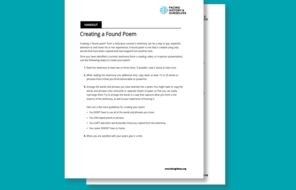[MUSIC PLAYING]
The found poems teaching strategy can be used to engage students in an online class discussion about a single text or a group of texts. This teaching strategy helps students to review material and synthesize their learning by creating a found poem. These poems use only words, phrases, or quotations that have been selected and rearranged from another text.
The found poems teaching strategy is best completed asynchronously within a defined time period, such as one or two days. It is also possible to complete some discussion steps in real time, synchronously with students.
Planning and facilitating student discussion when not physically present together can be challenging. So it's important to consider these questions before doing a found poems activity online with your students.
What collaborative digital tools do I want to use to facilitate found poems online? What is the defined time period I want to set for completing the activity? How am I going to deliver instructions to students for completing the activity? And how do I want to facilitate the sharing and discussion of student poems?
Before introducing the activity to students, identify the collaborative digital tool students will use to post their found poems. Padlet and Google Docs are examples of tools you can use for this activity. Also, identify how you will share the text students will work with to create their poems. For example, a shared Google folder.
Begin by asking students to review texts, such as journal entries or primary source documents. As students look over these texts, have them record words, phrases, or quotations they find meaningful. Students can take their notes either digitally or on paper. Both options work well for creating and sharing a found poem in an online environment.
Once students have a collection of words, phrases, and quotations, have them identify a theme and a message that reflects some or all of the language they have selected.
A theme is a broad concept, such as obedience, while a message is a specific idea they would like to express about this theme. It can be helpful for students to do this step with a partner. Consider having students work asynchronously in pairs using Google Docs. Students can also work with partners synchronously by scheduling time for a phone conversation or a Google Hangout meeting.
Before students begin arranging the language they collected, they may need to review their materials again for additional language. While students can repeat words or phrases as often as they like, found poems only use words that have been collected from other sources.
After students write their poems, have them silently read and then engage in an asynchronous discussion of others' poems. Consider having each student read three to four other poems, and write one comment for each poem they read. You could also have students share and discuss their poems synchronously. Consider having a few students read their poems aloud, and then facilitate a conversation using a chat function or having students unmute to respond.
To bring this activity to a close, have students reflect in their journals about what the poems reveal about the material they have just studied. A few prompts you might want to offer students include-- What strikes you about these poems? What do they have in common? How are they different? And what surprised you in reading them?
Taking found poems online provides an opportunity for students to review texts and synthesize their learning. It also creates a visual record of students thinking, that you and your students can refer back to at any time.
Let us know how you are using the found poems teaching strategy with your students. Share your ideas and ask questions in Facing History's Digital Lounge.



















